Organizational Learning and Development at Macy's Inc. Report Analysis
VerifiedAdded on 2021/11/19
|21
|5734
|258
Report
AI Summary
This report provides a comprehensive analysis of Macy's Inc.'s organizational learning and development (L&D) strategies. It begins with an executive summary highlighting the challenges and opportunities facing the retail giant in a transformative market. The introduction emphasizes the importance of human resources and customer experience in the luxury retail business, detailing Macy's 'Everyday Magic' strategy, which includes programs like Military Executive Development, Daily Boot Camp, and Employee Transition. The report then examines the organizational context, including mission, vision, and values, followed by a PESTLE analysis of the political, economic, social, technological, legal, and environmental factors affecting Macy's. The report discusses horizontal integration, structure, culture, and value addition. It also considers the L&D budget, analyzes employee capabilities, and delves into the design, delivery, and evaluation of L&D programs, including technology-based learning, coaching, and mentoring, and the application of Kirkpatrick's four-level assessment. Finally, the report assesses the return on investment (ROI) and return on expectations (ROE) of these initiatives, concluding with a summary of key findings and recommendations.
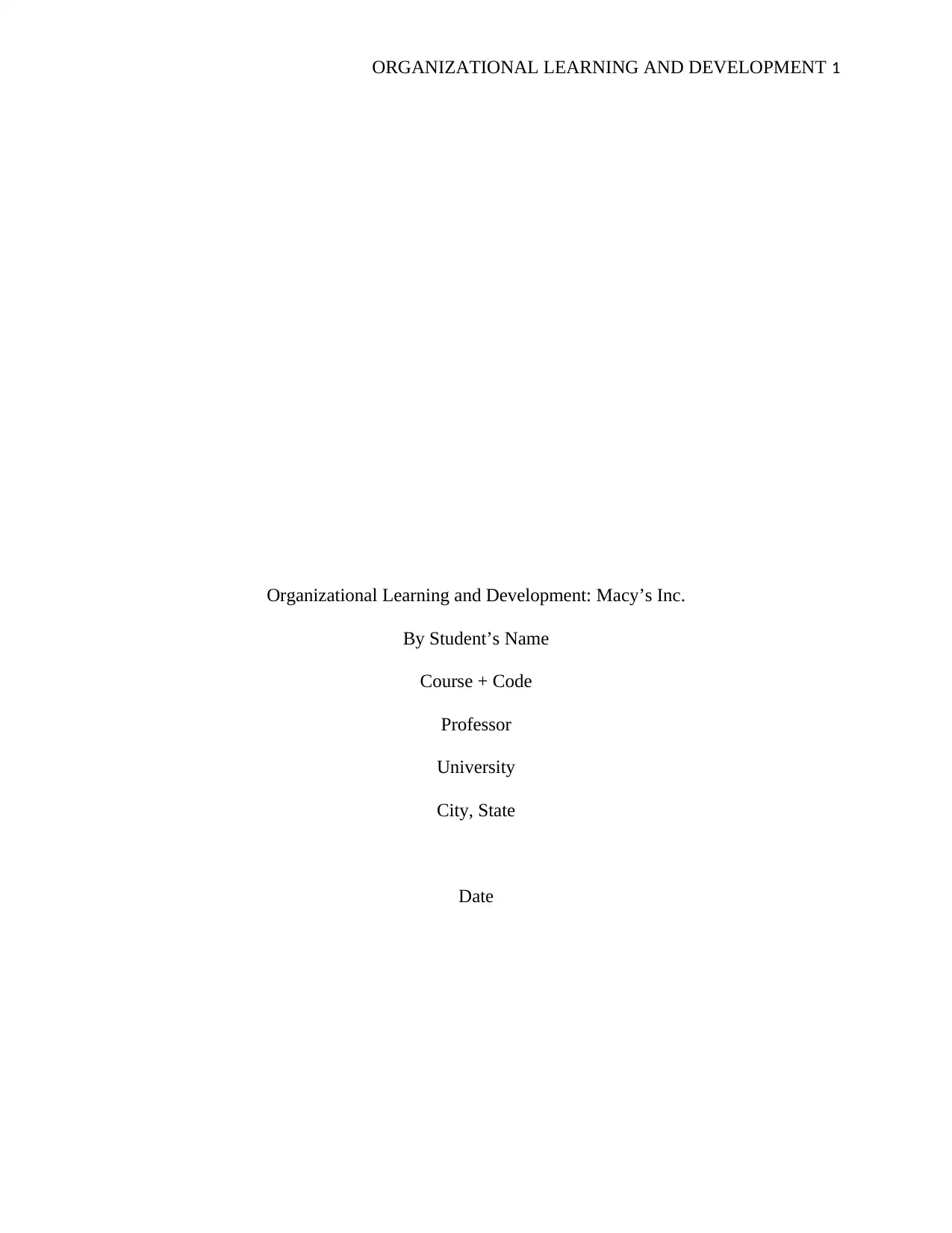
ORGANIZATIONAL LEARNING AND DEVELOPMENT 1
Organizational Learning and Development: Macy’s Inc.
By Student’s Name
Course + Code
Professor
University
City, State
Date
Organizational Learning and Development: Macy’s Inc.
By Student’s Name
Course + Code
Professor
University
City, State
Date
Paraphrase This Document
Need a fresh take? Get an instant paraphrase of this document with our AI Paraphraser
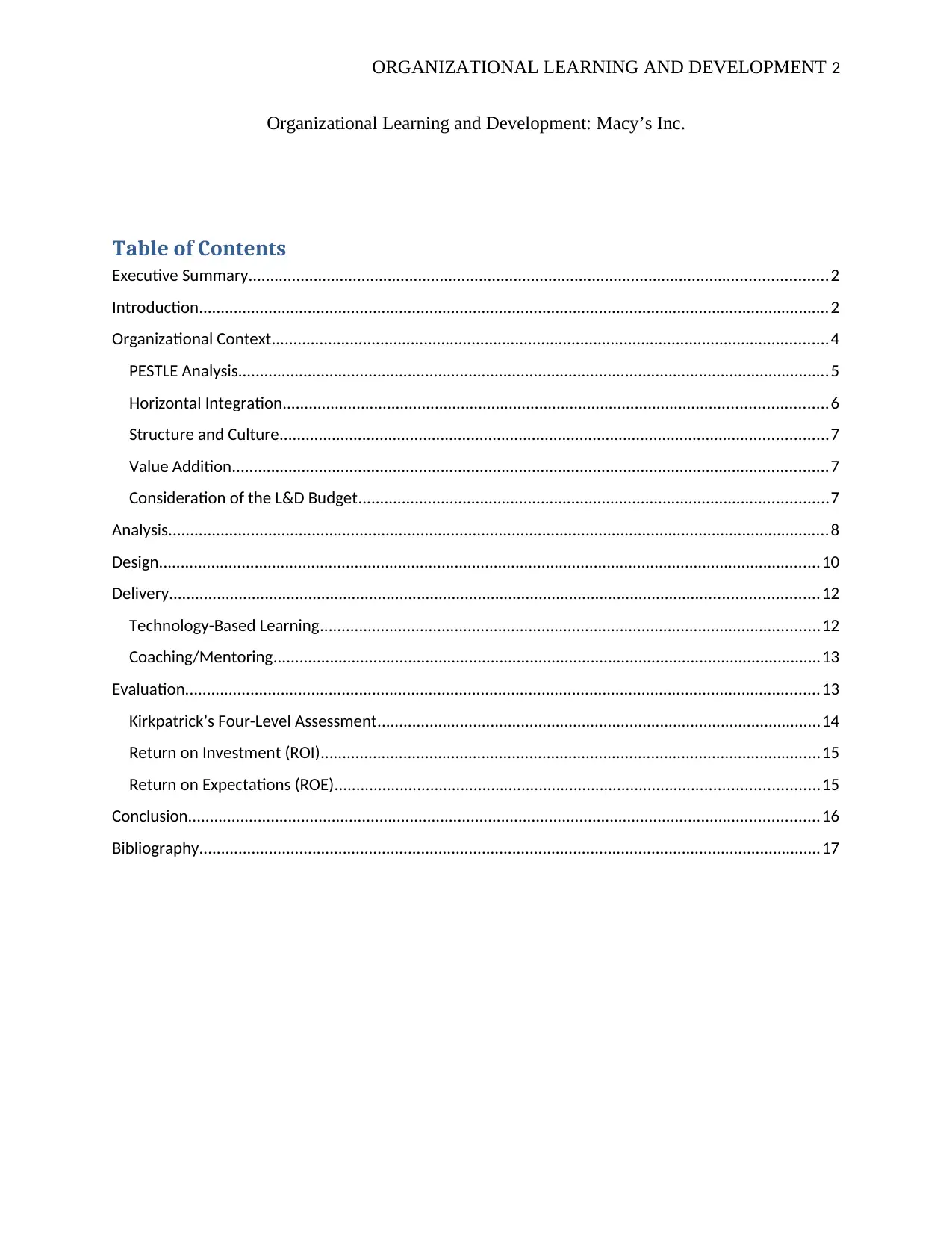
ORGANIZATIONAL LEARNING AND DEVELOPMENT 2
Organizational Learning and Development: Macy’s Inc.
Table of Contents
Executive Summary.....................................................................................................................................2
Introduction.................................................................................................................................................2
Organizational Context................................................................................................................................4
PESTLE Analysis........................................................................................................................................5
Horizontal Integration.............................................................................................................................6
Structure and Culture..............................................................................................................................7
Value Addition.........................................................................................................................................7
Consideration of the L&D Budget............................................................................................................7
Analysis........................................................................................................................................................8
Design........................................................................................................................................................10
Delivery.....................................................................................................................................................12
Technology-Based Learning...................................................................................................................12
Coaching/Mentoring..............................................................................................................................13
Evaluation..................................................................................................................................................13
Kirkpatrick’s Four-Level Assessment......................................................................................................14
Return on Investment (ROI)...................................................................................................................15
Return on Expectations (ROE)...............................................................................................................15
Conclusion.................................................................................................................................................16
Bibliography...............................................................................................................................................17
Organizational Learning and Development: Macy’s Inc.
Table of Contents
Executive Summary.....................................................................................................................................2
Introduction.................................................................................................................................................2
Organizational Context................................................................................................................................4
PESTLE Analysis........................................................................................................................................5
Horizontal Integration.............................................................................................................................6
Structure and Culture..............................................................................................................................7
Value Addition.........................................................................................................................................7
Consideration of the L&D Budget............................................................................................................7
Analysis........................................................................................................................................................8
Design........................................................................................................................................................10
Delivery.....................................................................................................................................................12
Technology-Based Learning...................................................................................................................12
Coaching/Mentoring..............................................................................................................................13
Evaluation..................................................................................................................................................13
Kirkpatrick’s Four-Level Assessment......................................................................................................14
Return on Investment (ROI)...................................................................................................................15
Return on Expectations (ROE)...............................................................................................................15
Conclusion.................................................................................................................................................16
Bibliography...............................................................................................................................................17
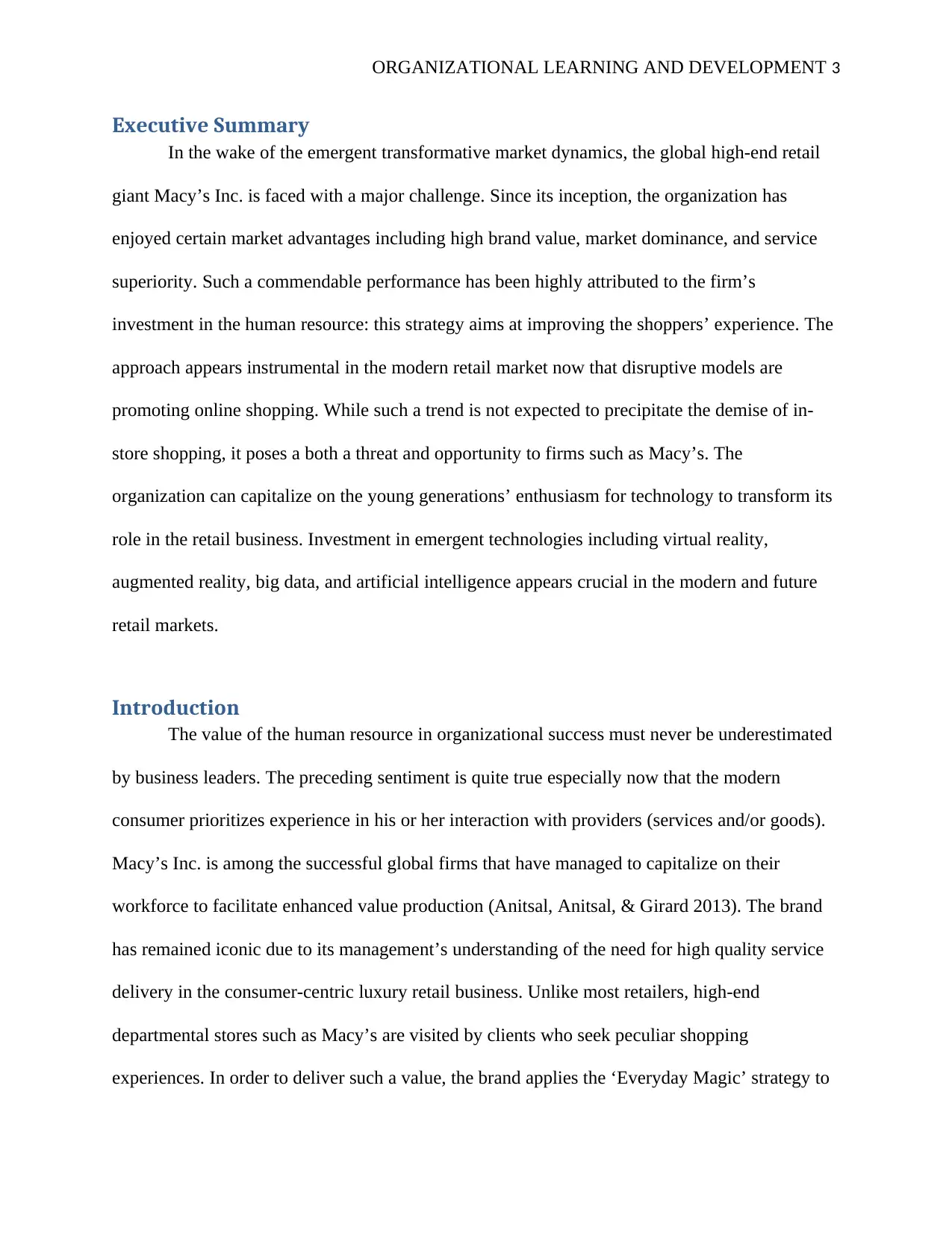
ORGANIZATIONAL LEARNING AND DEVELOPMENT 3
Executive Summary
In the wake of the emergent transformative market dynamics, the global high-end retail
giant Macy’s Inc. is faced with a major challenge. Since its inception, the organization has
enjoyed certain market advantages including high brand value, market dominance, and service
superiority. Such a commendable performance has been highly attributed to the firm’s
investment in the human resource: this strategy aims at improving the shoppers’ experience. The
approach appears instrumental in the modern retail market now that disruptive models are
promoting online shopping. While such a trend is not expected to precipitate the demise of in-
store shopping, it poses a both a threat and opportunity to firms such as Macy’s. The
organization can capitalize on the young generations’ enthusiasm for technology to transform its
role in the retail business. Investment in emergent technologies including virtual reality,
augmented reality, big data, and artificial intelligence appears crucial in the modern and future
retail markets.
Introduction
The value of the human resource in organizational success must never be underestimated
by business leaders. The preceding sentiment is quite true especially now that the modern
consumer prioritizes experience in his or her interaction with providers (services and/or goods).
Macy’s Inc. is among the successful global firms that have managed to capitalize on their
workforce to facilitate enhanced value production (Anitsal, Anitsal, & Girard 2013). The brand
has remained iconic due to its management’s understanding of the need for high quality service
delivery in the consumer-centric luxury retail business. Unlike most retailers, high-end
departmental stores such as Macy’s are visited by clients who seek peculiar shopping
experiences. In order to deliver such a value, the brand applies the ‘Everyday Magic’ strategy to
Executive Summary
In the wake of the emergent transformative market dynamics, the global high-end retail
giant Macy’s Inc. is faced with a major challenge. Since its inception, the organization has
enjoyed certain market advantages including high brand value, market dominance, and service
superiority. Such a commendable performance has been highly attributed to the firm’s
investment in the human resource: this strategy aims at improving the shoppers’ experience. The
approach appears instrumental in the modern retail market now that disruptive models are
promoting online shopping. While such a trend is not expected to precipitate the demise of in-
store shopping, it poses a both a threat and opportunity to firms such as Macy’s. The
organization can capitalize on the young generations’ enthusiasm for technology to transform its
role in the retail business. Investment in emergent technologies including virtual reality,
augmented reality, big data, and artificial intelligence appears crucial in the modern and future
retail markets.
Introduction
The value of the human resource in organizational success must never be underestimated
by business leaders. The preceding sentiment is quite true especially now that the modern
consumer prioritizes experience in his or her interaction with providers (services and/or goods).
Macy’s Inc. is among the successful global firms that have managed to capitalize on their
workforce to facilitate enhanced value production (Anitsal, Anitsal, & Girard 2013). The brand
has remained iconic due to its management’s understanding of the need for high quality service
delivery in the consumer-centric luxury retail business. Unlike most retailers, high-end
departmental stores such as Macy’s are visited by clients who seek peculiar shopping
experiences. In order to deliver such a value, the brand applies the ‘Everyday Magic’ strategy to
⊘ This is a preview!⊘
Do you want full access?
Subscribe today to unlock all pages.

Trusted by 1+ million students worldwide
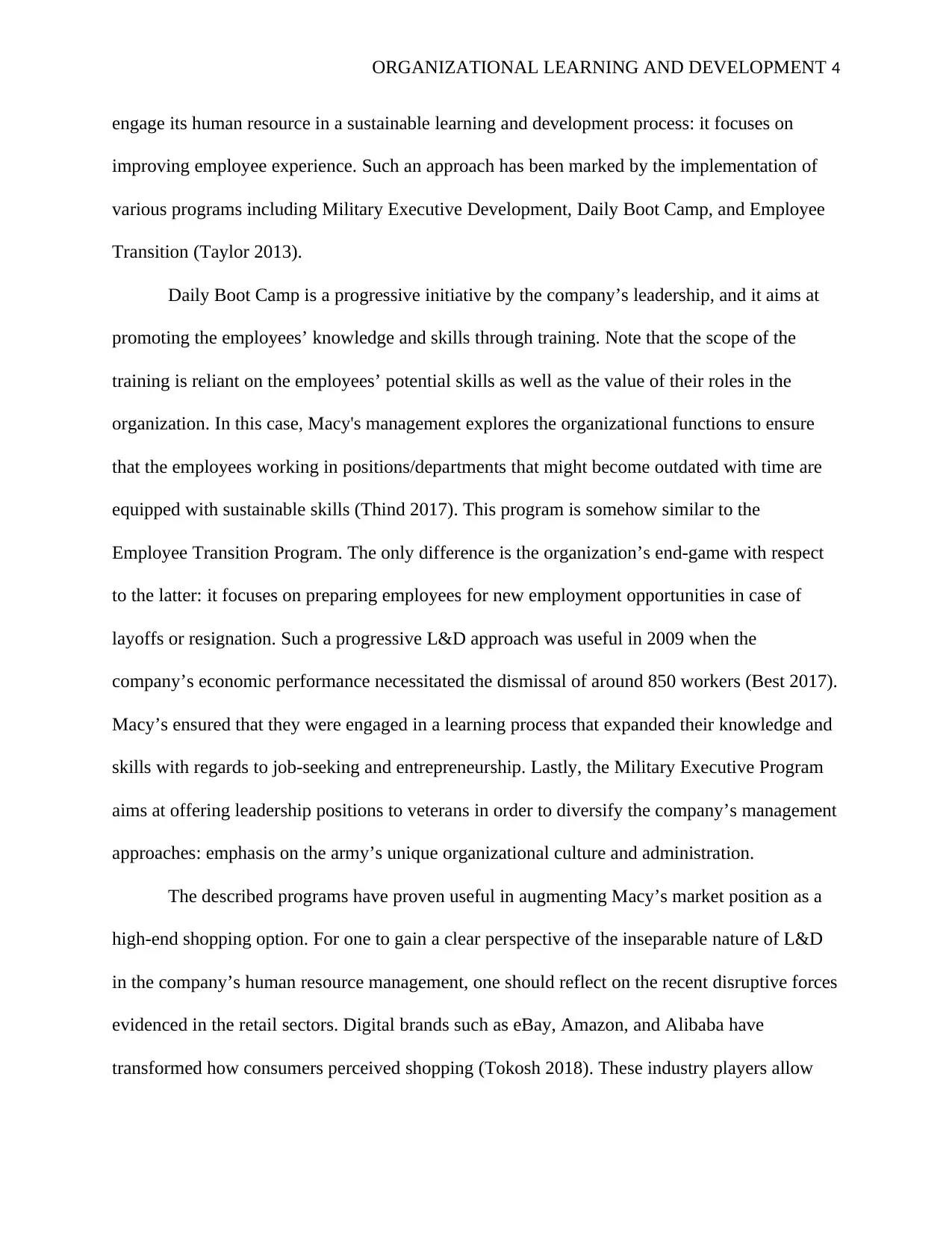
ORGANIZATIONAL LEARNING AND DEVELOPMENT 4
engage its human resource in a sustainable learning and development process: it focuses on
improving employee experience. Such an approach has been marked by the implementation of
various programs including Military Executive Development, Daily Boot Camp, and Employee
Transition (Taylor 2013).
Daily Boot Camp is a progressive initiative by the company’s leadership, and it aims at
promoting the employees’ knowledge and skills through training. Note that the scope of the
training is reliant on the employees’ potential skills as well as the value of their roles in the
organization. In this case, Macy's management explores the organizational functions to ensure
that the employees working in positions/departments that might become outdated with time are
equipped with sustainable skills (Thind 2017). This program is somehow similar to the
Employee Transition Program. The only difference is the organization’s end-game with respect
to the latter: it focuses on preparing employees for new employment opportunities in case of
layoffs or resignation. Such a progressive L&D approach was useful in 2009 when the
company’s economic performance necessitated the dismissal of around 850 workers (Best 2017).
Macy’s ensured that they were engaged in a learning process that expanded their knowledge and
skills with regards to job-seeking and entrepreneurship. Lastly, the Military Executive Program
aims at offering leadership positions to veterans in order to diversify the company’s management
approaches: emphasis on the army’s unique organizational culture and administration.
The described programs have proven useful in augmenting Macy’s market position as a
high-end shopping option. For one to gain a clear perspective of the inseparable nature of L&D
in the company’s human resource management, one should reflect on the recent disruptive forces
evidenced in the retail sectors. Digital brands such as eBay, Amazon, and Alibaba have
transformed how consumers perceived shopping (Tokosh 2018). These industry players allow
engage its human resource in a sustainable learning and development process: it focuses on
improving employee experience. Such an approach has been marked by the implementation of
various programs including Military Executive Development, Daily Boot Camp, and Employee
Transition (Taylor 2013).
Daily Boot Camp is a progressive initiative by the company’s leadership, and it aims at
promoting the employees’ knowledge and skills through training. Note that the scope of the
training is reliant on the employees’ potential skills as well as the value of their roles in the
organization. In this case, Macy's management explores the organizational functions to ensure
that the employees working in positions/departments that might become outdated with time are
equipped with sustainable skills (Thind 2017). This program is somehow similar to the
Employee Transition Program. The only difference is the organization’s end-game with respect
to the latter: it focuses on preparing employees for new employment opportunities in case of
layoffs or resignation. Such a progressive L&D approach was useful in 2009 when the
company’s economic performance necessitated the dismissal of around 850 workers (Best 2017).
Macy’s ensured that they were engaged in a learning process that expanded their knowledge and
skills with regards to job-seeking and entrepreneurship. Lastly, the Military Executive Program
aims at offering leadership positions to veterans in order to diversify the company’s management
approaches: emphasis on the army’s unique organizational culture and administration.
The described programs have proven useful in augmenting Macy’s market position as a
high-end shopping option. For one to gain a clear perspective of the inseparable nature of L&D
in the company’s human resource management, one should reflect on the recent disruptive forces
evidenced in the retail sectors. Digital brands such as eBay, Amazon, and Alibaba have
transformed how consumers perceived shopping (Tokosh 2018). These industry players allow
Paraphrase This Document
Need a fresh take? Get an instant paraphrase of this document with our AI Paraphraser
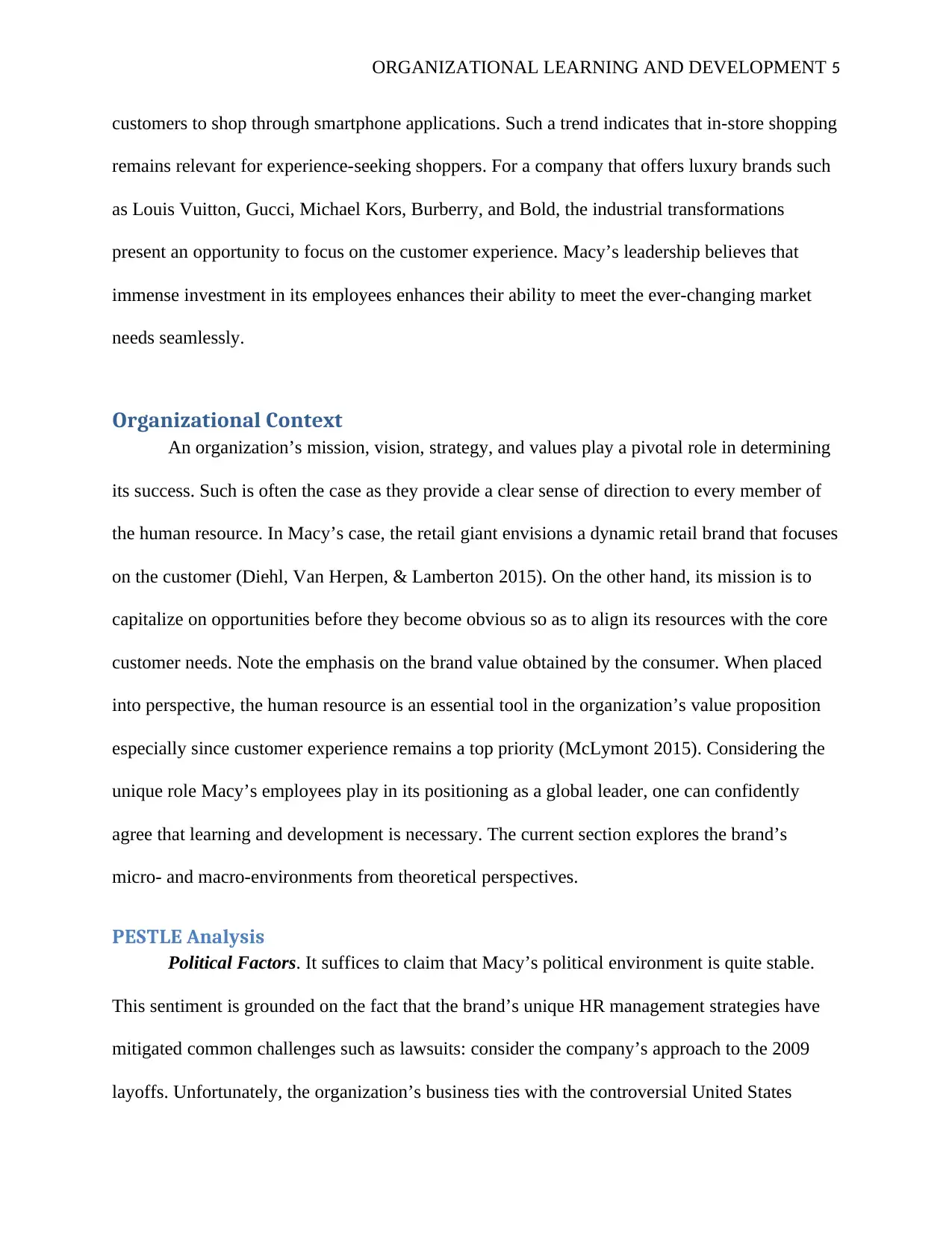
ORGANIZATIONAL LEARNING AND DEVELOPMENT 5
customers to shop through smartphone applications. Such a trend indicates that in-store shopping
remains relevant for experience-seeking shoppers. For a company that offers luxury brands such
as Louis Vuitton, Gucci, Michael Kors, Burberry, and Bold, the industrial transformations
present an opportunity to focus on the customer experience. Macy’s leadership believes that
immense investment in its employees enhances their ability to meet the ever-changing market
needs seamlessly.
Organizational Context
An organization’s mission, vision, strategy, and values play a pivotal role in determining
its success. Such is often the case as they provide a clear sense of direction to every member of
the human resource. In Macy’s case, the retail giant envisions a dynamic retail brand that focuses
on the customer (Diehl, Van Herpen, & Lamberton 2015). On the other hand, its mission is to
capitalize on opportunities before they become obvious so as to align its resources with the core
customer needs. Note the emphasis on the brand value obtained by the consumer. When placed
into perspective, the human resource is an essential tool in the organization’s value proposition
especially since customer experience remains a top priority (McLymont 2015). Considering the
unique role Macy’s employees play in its positioning as a global leader, one can confidently
agree that learning and development is necessary. The current section explores the brand’s
micro- and macro-environments from theoretical perspectives.
PESTLE Analysis
Political Factors. It suffices to claim that Macy’s political environment is quite stable.
This sentiment is grounded on the fact that the brand’s unique HR management strategies have
mitigated common challenges such as lawsuits: consider the company’s approach to the 2009
layoffs. Unfortunately, the organization’s business ties with the controversial United States
customers to shop through smartphone applications. Such a trend indicates that in-store shopping
remains relevant for experience-seeking shoppers. For a company that offers luxury brands such
as Louis Vuitton, Gucci, Michael Kors, Burberry, and Bold, the industrial transformations
present an opportunity to focus on the customer experience. Macy’s leadership believes that
immense investment in its employees enhances their ability to meet the ever-changing market
needs seamlessly.
Organizational Context
An organization’s mission, vision, strategy, and values play a pivotal role in determining
its success. Such is often the case as they provide a clear sense of direction to every member of
the human resource. In Macy’s case, the retail giant envisions a dynamic retail brand that focuses
on the customer (Diehl, Van Herpen, & Lamberton 2015). On the other hand, its mission is to
capitalize on opportunities before they become obvious so as to align its resources with the core
customer needs. Note the emphasis on the brand value obtained by the consumer. When placed
into perspective, the human resource is an essential tool in the organization’s value proposition
especially since customer experience remains a top priority (McLymont 2015). Considering the
unique role Macy’s employees play in its positioning as a global leader, one can confidently
agree that learning and development is necessary. The current section explores the brand’s
micro- and macro-environments from theoretical perspectives.
PESTLE Analysis
Political Factors. It suffices to claim that Macy’s political environment is quite stable.
This sentiment is grounded on the fact that the brand’s unique HR management strategies have
mitigated common challenges such as lawsuits: consider the company’s approach to the 2009
layoffs. Unfortunately, the organization’s business ties with the controversial United States
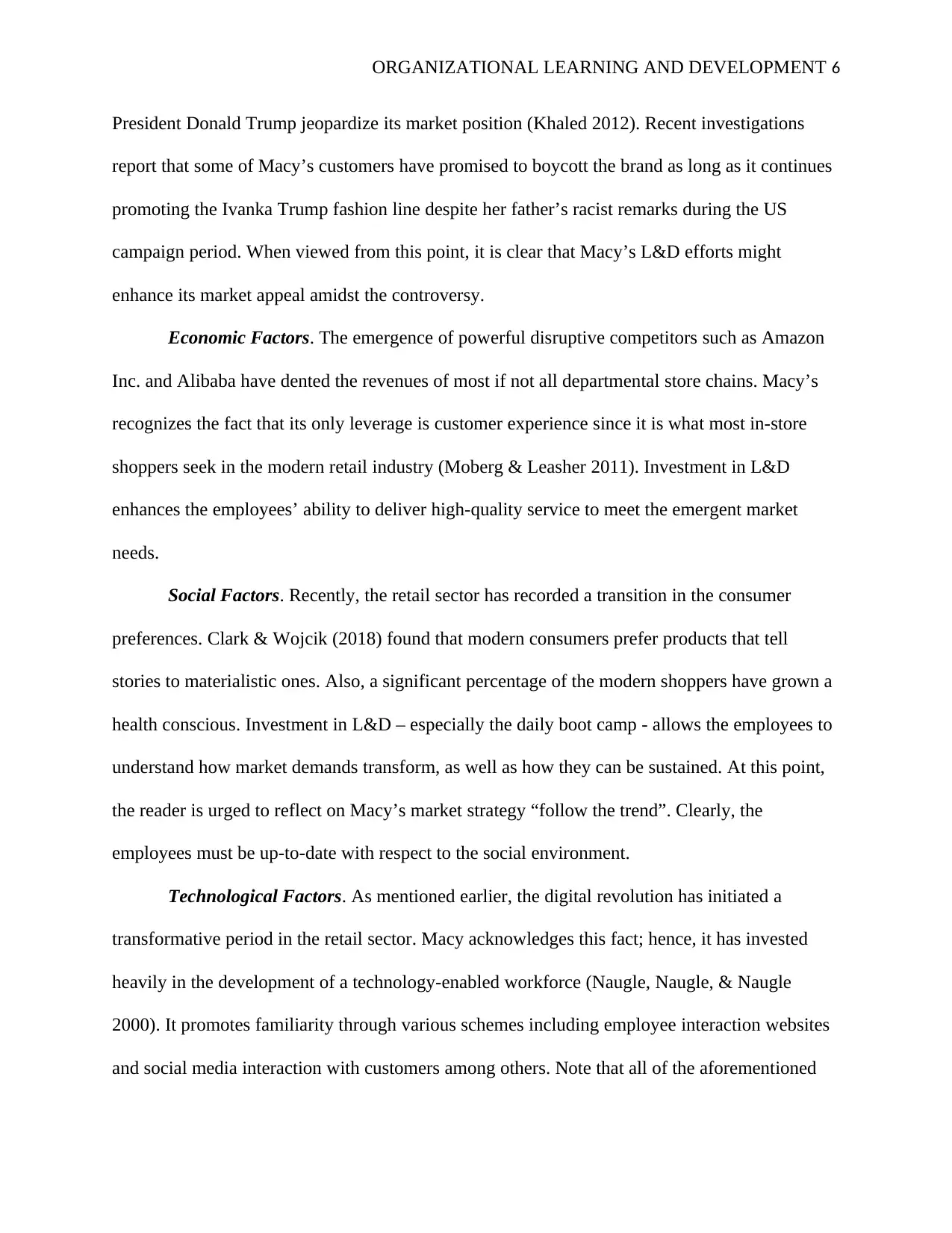
ORGANIZATIONAL LEARNING AND DEVELOPMENT 6
President Donald Trump jeopardize its market position (Khaled 2012). Recent investigations
report that some of Macy’s customers have promised to boycott the brand as long as it continues
promoting the Ivanka Trump fashion line despite her father’s racist remarks during the US
campaign period. When viewed from this point, it is clear that Macy’s L&D efforts might
enhance its market appeal amidst the controversy.
Economic Factors. The emergence of powerful disruptive competitors such as Amazon
Inc. and Alibaba have dented the revenues of most if not all departmental store chains. Macy’s
recognizes the fact that its only leverage is customer experience since it is what most in-store
shoppers seek in the modern retail industry (Moberg & Leasher 2011). Investment in L&D
enhances the employees’ ability to deliver high-quality service to meet the emergent market
needs.
Social Factors. Recently, the retail sector has recorded a transition in the consumer
preferences. Clark & Wojcik (2018) found that modern consumers prefer products that tell
stories to materialistic ones. Also, a significant percentage of the modern shoppers have grown a
health conscious. Investment in L&D – especially the daily boot camp - allows the employees to
understand how market demands transform, as well as how they can be sustained. At this point,
the reader is urged to reflect on Macy’s market strategy “follow the trend”. Clearly, the
employees must be up-to-date with respect to the social environment.
Technological Factors. As mentioned earlier, the digital revolution has initiated a
transformative period in the retail sector. Macy acknowledges this fact; hence, it has invested
heavily in the development of a technology-enabled workforce (Naugle, Naugle, & Naugle
2000). It promotes familiarity through various schemes including employee interaction websites
and social media interaction with customers among others. Note that all of the aforementioned
President Donald Trump jeopardize its market position (Khaled 2012). Recent investigations
report that some of Macy’s customers have promised to boycott the brand as long as it continues
promoting the Ivanka Trump fashion line despite her father’s racist remarks during the US
campaign period. When viewed from this point, it is clear that Macy’s L&D efforts might
enhance its market appeal amidst the controversy.
Economic Factors. The emergence of powerful disruptive competitors such as Amazon
Inc. and Alibaba have dented the revenues of most if not all departmental store chains. Macy’s
recognizes the fact that its only leverage is customer experience since it is what most in-store
shoppers seek in the modern retail industry (Moberg & Leasher 2011). Investment in L&D
enhances the employees’ ability to deliver high-quality service to meet the emergent market
needs.
Social Factors. Recently, the retail sector has recorded a transition in the consumer
preferences. Clark & Wojcik (2018) found that modern consumers prefer products that tell
stories to materialistic ones. Also, a significant percentage of the modern shoppers have grown a
health conscious. Investment in L&D – especially the daily boot camp - allows the employees to
understand how market demands transform, as well as how they can be sustained. At this point,
the reader is urged to reflect on Macy’s market strategy “follow the trend”. Clearly, the
employees must be up-to-date with respect to the social environment.
Technological Factors. As mentioned earlier, the digital revolution has initiated a
transformative period in the retail sector. Macy acknowledges this fact; hence, it has invested
heavily in the development of a technology-enabled workforce (Naugle, Naugle, & Naugle
2000). It promotes familiarity through various schemes including employee interaction websites
and social media interaction with customers among others. Note that all of the aforementioned
⊘ This is a preview!⊘
Do you want full access?
Subscribe today to unlock all pages.

Trusted by 1+ million students worldwide
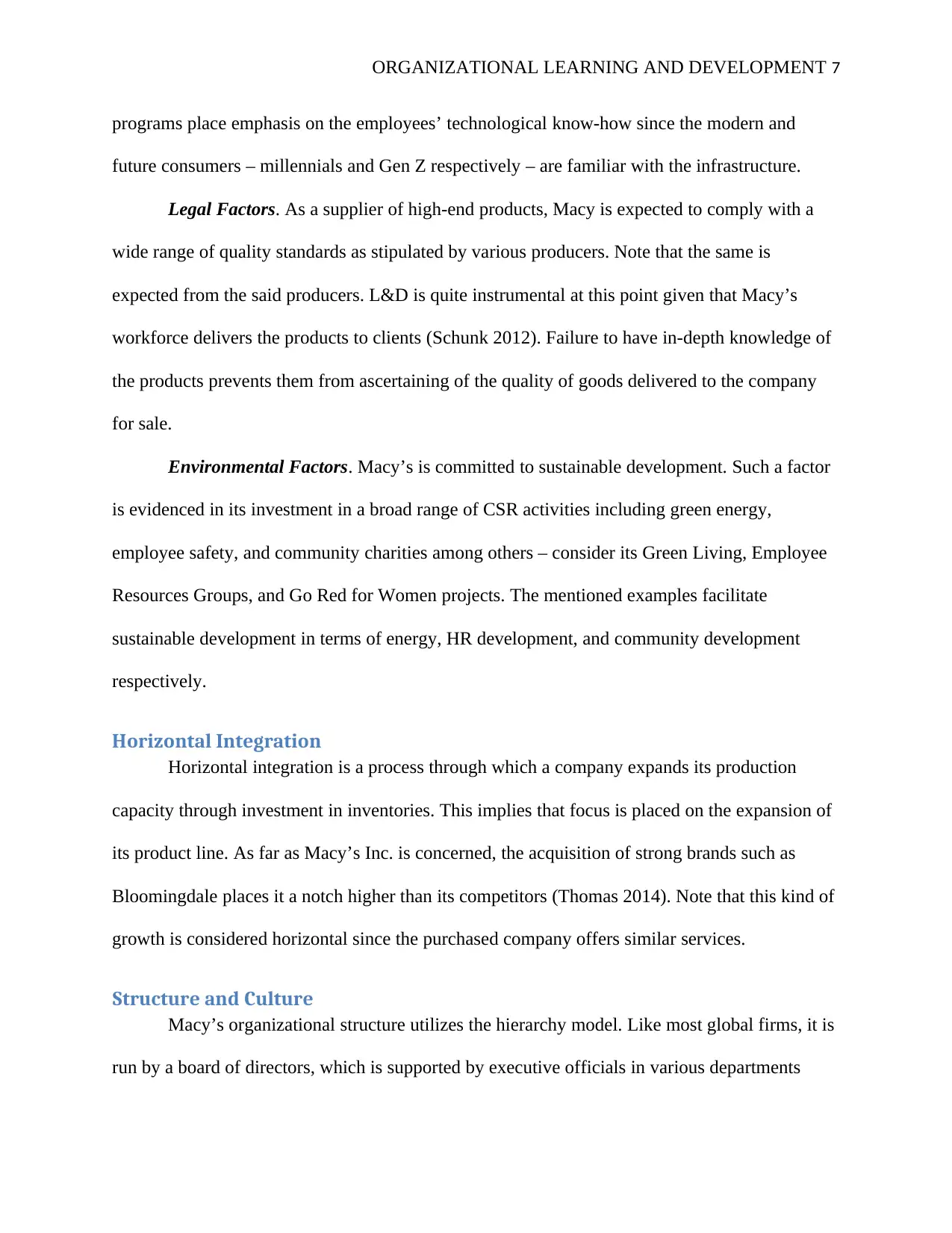
ORGANIZATIONAL LEARNING AND DEVELOPMENT 7
programs place emphasis on the employees’ technological know-how since the modern and
future consumers – millennials and Gen Z respectively – are familiar with the infrastructure.
Legal Factors. As a supplier of high-end products, Macy is expected to comply with a
wide range of quality standards as stipulated by various producers. Note that the same is
expected from the said producers. L&D is quite instrumental at this point given that Macy’s
workforce delivers the products to clients (Schunk 2012). Failure to have in-depth knowledge of
the products prevents them from ascertaining of the quality of goods delivered to the company
for sale.
Environmental Factors. Macy’s is committed to sustainable development. Such a factor
is evidenced in its investment in a broad range of CSR activities including green energy,
employee safety, and community charities among others – consider its Green Living, Employee
Resources Groups, and Go Red for Women projects. The mentioned examples facilitate
sustainable development in terms of energy, HR development, and community development
respectively.
Horizontal Integration
Horizontal integration is a process through which a company expands its production
capacity through investment in inventories. This implies that focus is placed on the expansion of
its product line. As far as Macy’s Inc. is concerned, the acquisition of strong brands such as
Bloomingdale places it a notch higher than its competitors (Thomas 2014). Note that this kind of
growth is considered horizontal since the purchased company offers similar services.
Structure and Culture
Macy’s organizational structure utilizes the hierarchy model. Like most global firms, it is
run by a board of directors, which is supported by executive officials in various departments
programs place emphasis on the employees’ technological know-how since the modern and
future consumers – millennials and Gen Z respectively – are familiar with the infrastructure.
Legal Factors. As a supplier of high-end products, Macy is expected to comply with a
wide range of quality standards as stipulated by various producers. Note that the same is
expected from the said producers. L&D is quite instrumental at this point given that Macy’s
workforce delivers the products to clients (Schunk 2012). Failure to have in-depth knowledge of
the products prevents them from ascertaining of the quality of goods delivered to the company
for sale.
Environmental Factors. Macy’s is committed to sustainable development. Such a factor
is evidenced in its investment in a broad range of CSR activities including green energy,
employee safety, and community charities among others – consider its Green Living, Employee
Resources Groups, and Go Red for Women projects. The mentioned examples facilitate
sustainable development in terms of energy, HR development, and community development
respectively.
Horizontal Integration
Horizontal integration is a process through which a company expands its production
capacity through investment in inventories. This implies that focus is placed on the expansion of
its product line. As far as Macy’s Inc. is concerned, the acquisition of strong brands such as
Bloomingdale places it a notch higher than its competitors (Thomas 2014). Note that this kind of
growth is considered horizontal since the purchased company offers similar services.
Structure and Culture
Macy’s organizational structure utilizes the hierarchy model. Like most global firms, it is
run by a board of directors, which is supported by executive officials in various departments
Paraphrase This Document
Need a fresh take? Get an instant paraphrase of this document with our AI Paraphraser
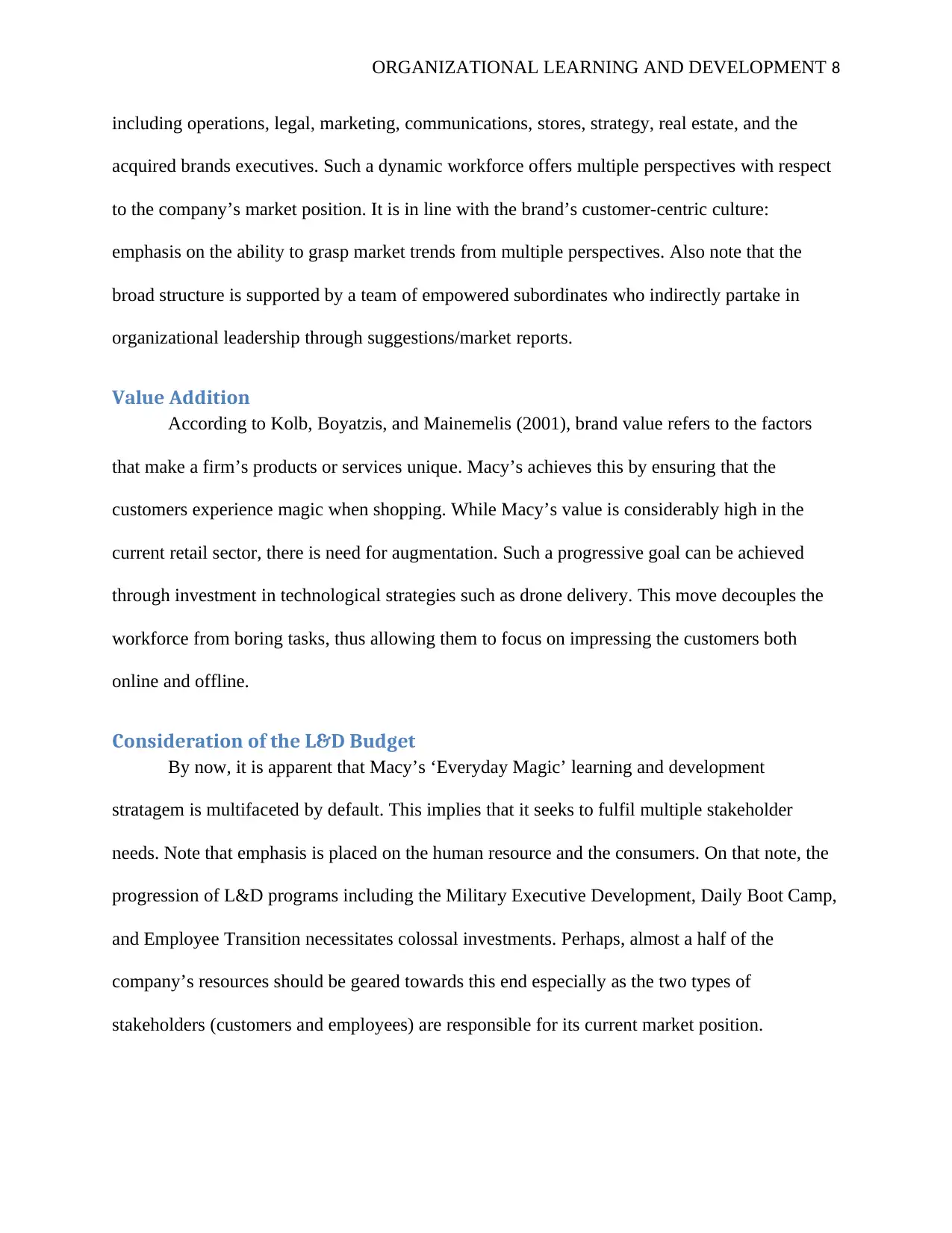
ORGANIZATIONAL LEARNING AND DEVELOPMENT 8
including operations, legal, marketing, communications, stores, strategy, real estate, and the
acquired brands executives. Such a dynamic workforce offers multiple perspectives with respect
to the company’s market position. It is in line with the brand’s customer-centric culture:
emphasis on the ability to grasp market trends from multiple perspectives. Also note that the
broad structure is supported by a team of empowered subordinates who indirectly partake in
organizational leadership through suggestions/market reports.
Value Addition
According to Kolb, Boyatzis, and Mainemelis (2001), brand value refers to the factors
that make a firm’s products or services unique. Macy’s achieves this by ensuring that the
customers experience magic when shopping. While Macy’s value is considerably high in the
current retail sector, there is need for augmentation. Such a progressive goal can be achieved
through investment in technological strategies such as drone delivery. This move decouples the
workforce from boring tasks, thus allowing them to focus on impressing the customers both
online and offline.
Consideration of the L&D Budget
By now, it is apparent that Macy’s ‘Everyday Magic’ learning and development
stratagem is multifaceted by default. This implies that it seeks to fulfil multiple stakeholder
needs. Note that emphasis is placed on the human resource and the consumers. On that note, the
progression of L&D programs including the Military Executive Development, Daily Boot Camp,
and Employee Transition necessitates colossal investments. Perhaps, almost a half of the
company’s resources should be geared towards this end especially as the two types of
stakeholders (customers and employees) are responsible for its current market position.
including operations, legal, marketing, communications, stores, strategy, real estate, and the
acquired brands executives. Such a dynamic workforce offers multiple perspectives with respect
to the company’s market position. It is in line with the brand’s customer-centric culture:
emphasis on the ability to grasp market trends from multiple perspectives. Also note that the
broad structure is supported by a team of empowered subordinates who indirectly partake in
organizational leadership through suggestions/market reports.
Value Addition
According to Kolb, Boyatzis, and Mainemelis (2001), brand value refers to the factors
that make a firm’s products or services unique. Macy’s achieves this by ensuring that the
customers experience magic when shopping. While Macy’s value is considerably high in the
current retail sector, there is need for augmentation. Such a progressive goal can be achieved
through investment in technological strategies such as drone delivery. This move decouples the
workforce from boring tasks, thus allowing them to focus on impressing the customers both
online and offline.
Consideration of the L&D Budget
By now, it is apparent that Macy’s ‘Everyday Magic’ learning and development
stratagem is multifaceted by default. This implies that it seeks to fulfil multiple stakeholder
needs. Note that emphasis is placed on the human resource and the consumers. On that note, the
progression of L&D programs including the Military Executive Development, Daily Boot Camp,
and Employee Transition necessitates colossal investments. Perhaps, almost a half of the
company’s resources should be geared towards this end especially as the two types of
stakeholders (customers and employees) are responsible for its current market position.
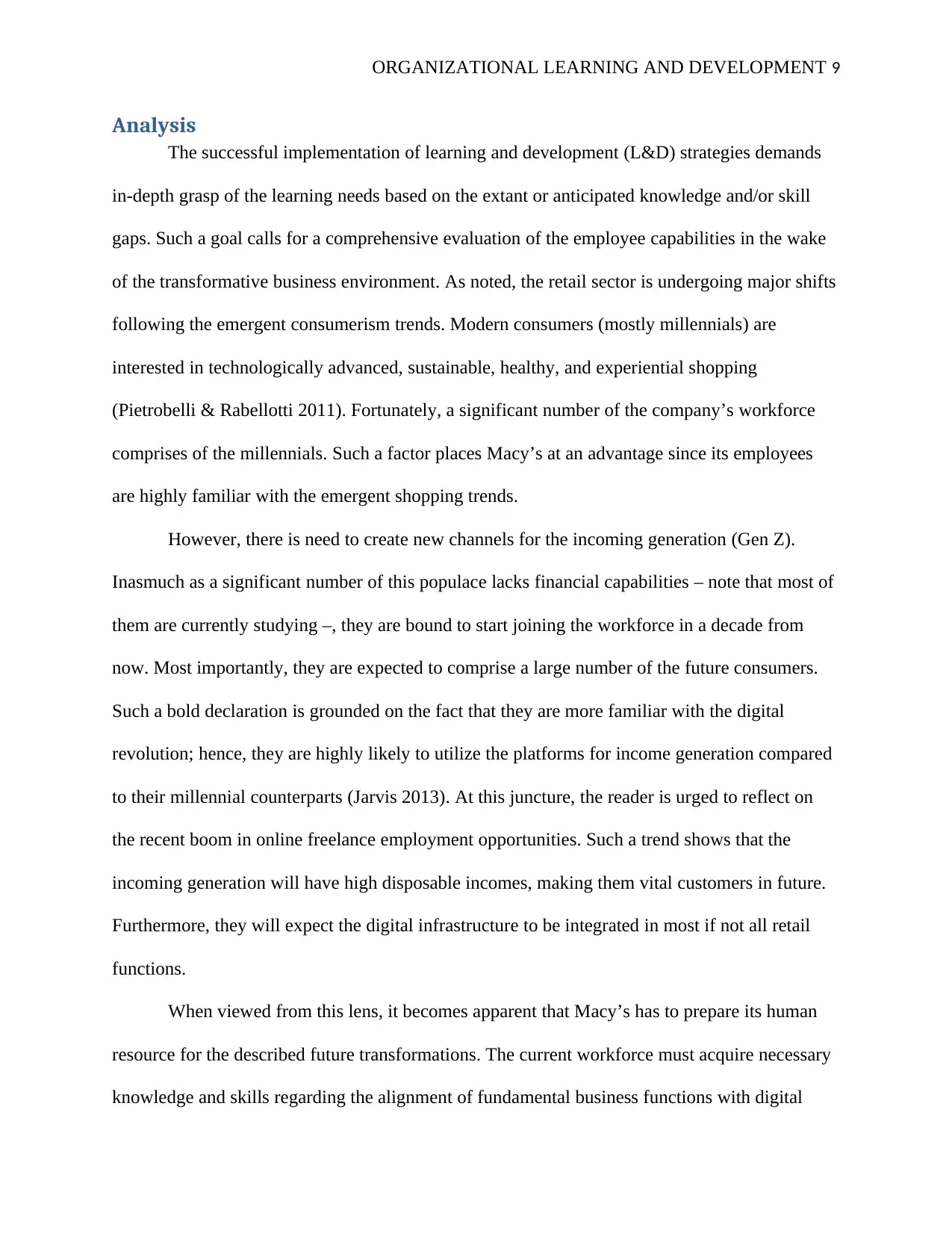
ORGANIZATIONAL LEARNING AND DEVELOPMENT 9
Analysis
The successful implementation of learning and development (L&D) strategies demands
in-depth grasp of the learning needs based on the extant or anticipated knowledge and/or skill
gaps. Such a goal calls for a comprehensive evaluation of the employee capabilities in the wake
of the transformative business environment. As noted, the retail sector is undergoing major shifts
following the emergent consumerism trends. Modern consumers (mostly millennials) are
interested in technologically advanced, sustainable, healthy, and experiential shopping
(Pietrobelli & Rabellotti 2011). Fortunately, a significant number of the company’s workforce
comprises of the millennials. Such a factor places Macy’s at an advantage since its employees
are highly familiar with the emergent shopping trends.
However, there is need to create new channels for the incoming generation (Gen Z).
Inasmuch as a significant number of this populace lacks financial capabilities – note that most of
them are currently studying –, they are bound to start joining the workforce in a decade from
now. Most importantly, they are expected to comprise a large number of the future consumers.
Such a bold declaration is grounded on the fact that they are more familiar with the digital
revolution; hence, they are highly likely to utilize the platforms for income generation compared
to their millennial counterparts (Jarvis 2013). At this juncture, the reader is urged to reflect on
the recent boom in online freelance employment opportunities. Such a trend shows that the
incoming generation will have high disposable incomes, making them vital customers in future.
Furthermore, they will expect the digital infrastructure to be integrated in most if not all retail
functions.
When viewed from this lens, it becomes apparent that Macy’s has to prepare its human
resource for the described future transformations. The current workforce must acquire necessary
knowledge and skills regarding the alignment of fundamental business functions with digital
Analysis
The successful implementation of learning and development (L&D) strategies demands
in-depth grasp of the learning needs based on the extant or anticipated knowledge and/or skill
gaps. Such a goal calls for a comprehensive evaluation of the employee capabilities in the wake
of the transformative business environment. As noted, the retail sector is undergoing major shifts
following the emergent consumerism trends. Modern consumers (mostly millennials) are
interested in technologically advanced, sustainable, healthy, and experiential shopping
(Pietrobelli & Rabellotti 2011). Fortunately, a significant number of the company’s workforce
comprises of the millennials. Such a factor places Macy’s at an advantage since its employees
are highly familiar with the emergent shopping trends.
However, there is need to create new channels for the incoming generation (Gen Z).
Inasmuch as a significant number of this populace lacks financial capabilities – note that most of
them are currently studying –, they are bound to start joining the workforce in a decade from
now. Most importantly, they are expected to comprise a large number of the future consumers.
Such a bold declaration is grounded on the fact that they are more familiar with the digital
revolution; hence, they are highly likely to utilize the platforms for income generation compared
to their millennial counterparts (Jarvis 2013). At this juncture, the reader is urged to reflect on
the recent boom in online freelance employment opportunities. Such a trend shows that the
incoming generation will have high disposable incomes, making them vital customers in future.
Furthermore, they will expect the digital infrastructure to be integrated in most if not all retail
functions.
When viewed from this lens, it becomes apparent that Macy’s has to prepare its human
resource for the described future transformations. The current workforce must acquire necessary
knowledge and skills regarding the alignment of fundamental business functions with digital
⊘ This is a preview!⊘
Do you want full access?
Subscribe today to unlock all pages.

Trusted by 1+ million students worldwide
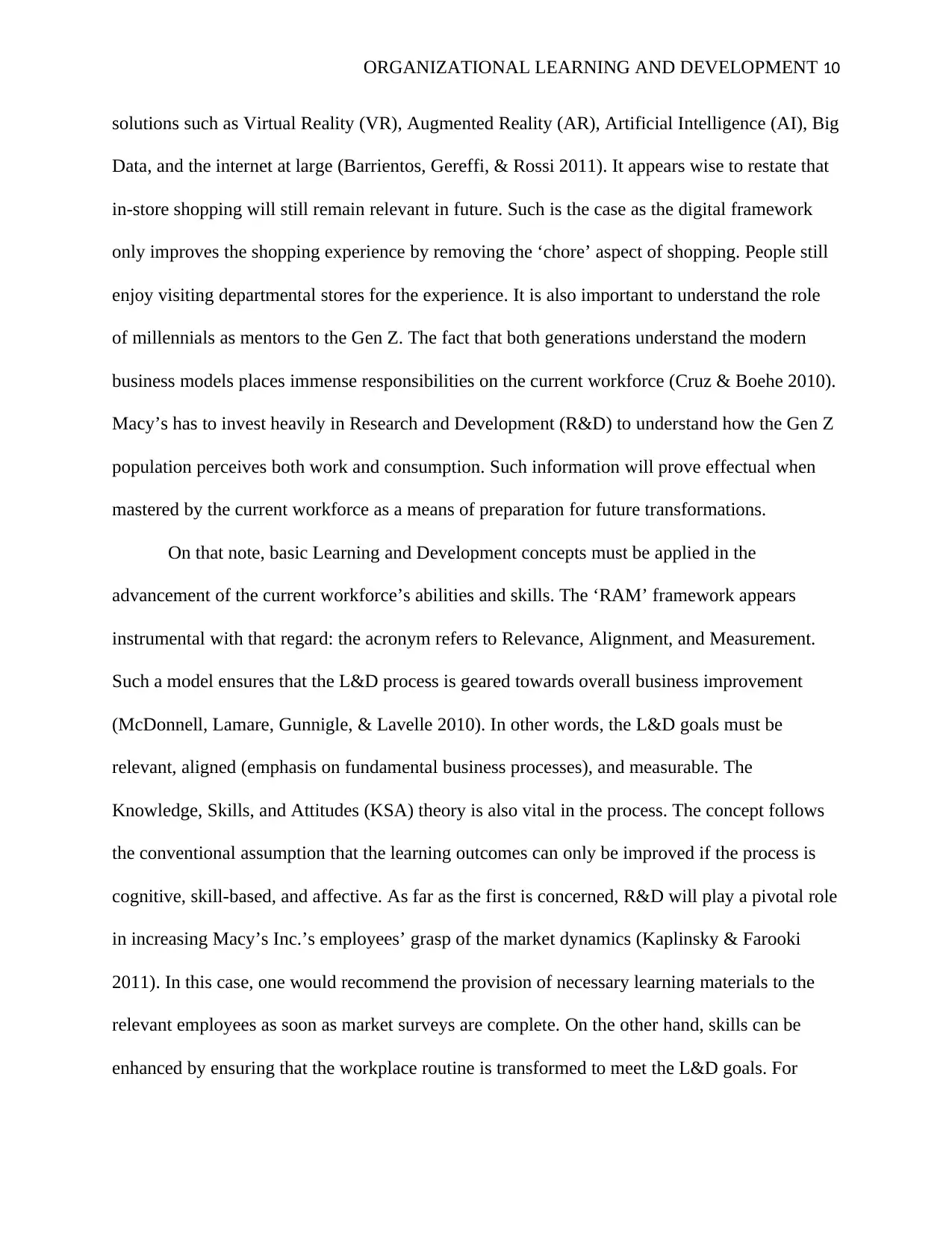
ORGANIZATIONAL LEARNING AND DEVELOPMENT 10
solutions such as Virtual Reality (VR), Augmented Reality (AR), Artificial Intelligence (AI), Big
Data, and the internet at large (Barrientos, Gereffi, & Rossi 2011). It appears wise to restate that
in-store shopping will still remain relevant in future. Such is the case as the digital framework
only improves the shopping experience by removing the ‘chore’ aspect of shopping. People still
enjoy visiting departmental stores for the experience. It is also important to understand the role
of millennials as mentors to the Gen Z. The fact that both generations understand the modern
business models places immense responsibilities on the current workforce (Cruz & Boehe 2010).
Macy’s has to invest heavily in Research and Development (R&D) to understand how the Gen Z
population perceives both work and consumption. Such information will prove effectual when
mastered by the current workforce as a means of preparation for future transformations.
On that note, basic Learning and Development concepts must be applied in the
advancement of the current workforce’s abilities and skills. The ‘RAM’ framework appears
instrumental with that regard: the acronym refers to Relevance, Alignment, and Measurement.
Such a model ensures that the L&D process is geared towards overall business improvement
(McDonnell, Lamare, Gunnigle, & Lavelle 2010). In other words, the L&D goals must be
relevant, aligned (emphasis on fundamental business processes), and measurable. The
Knowledge, Skills, and Attitudes (KSA) theory is also vital in the process. The concept follows
the conventional assumption that the learning outcomes can only be improved if the process is
cognitive, skill-based, and affective. As far as the first is concerned, R&D will play a pivotal role
in increasing Macy’s Inc.’s employees’ grasp of the market dynamics (Kaplinsky & Farooki
2011). In this case, one would recommend the provision of necessary learning materials to the
relevant employees as soon as market surveys are complete. On the other hand, skills can be
enhanced by ensuring that the workplace routine is transformed to meet the L&D goals. For
solutions such as Virtual Reality (VR), Augmented Reality (AR), Artificial Intelligence (AI), Big
Data, and the internet at large (Barrientos, Gereffi, & Rossi 2011). It appears wise to restate that
in-store shopping will still remain relevant in future. Such is the case as the digital framework
only improves the shopping experience by removing the ‘chore’ aspect of shopping. People still
enjoy visiting departmental stores for the experience. It is also important to understand the role
of millennials as mentors to the Gen Z. The fact that both generations understand the modern
business models places immense responsibilities on the current workforce (Cruz & Boehe 2010).
Macy’s has to invest heavily in Research and Development (R&D) to understand how the Gen Z
population perceives both work and consumption. Such information will prove effectual when
mastered by the current workforce as a means of preparation for future transformations.
On that note, basic Learning and Development concepts must be applied in the
advancement of the current workforce’s abilities and skills. The ‘RAM’ framework appears
instrumental with that regard: the acronym refers to Relevance, Alignment, and Measurement.
Such a model ensures that the L&D process is geared towards overall business improvement
(McDonnell, Lamare, Gunnigle, & Lavelle 2010). In other words, the L&D goals must be
relevant, aligned (emphasis on fundamental business processes), and measurable. The
Knowledge, Skills, and Attitudes (KSA) theory is also vital in the process. The concept follows
the conventional assumption that the learning outcomes can only be improved if the process is
cognitive, skill-based, and affective. As far as the first is concerned, R&D will play a pivotal role
in increasing Macy’s Inc.’s employees’ grasp of the market dynamics (Kaplinsky & Farooki
2011). In this case, one would recommend the provision of necessary learning materials to the
relevant employees as soon as market surveys are complete. On the other hand, skills can be
enhanced by ensuring that the workplace routine is transformed to meet the L&D goals. For
Paraphrase This Document
Need a fresh take? Get an instant paraphrase of this document with our AI Paraphraser
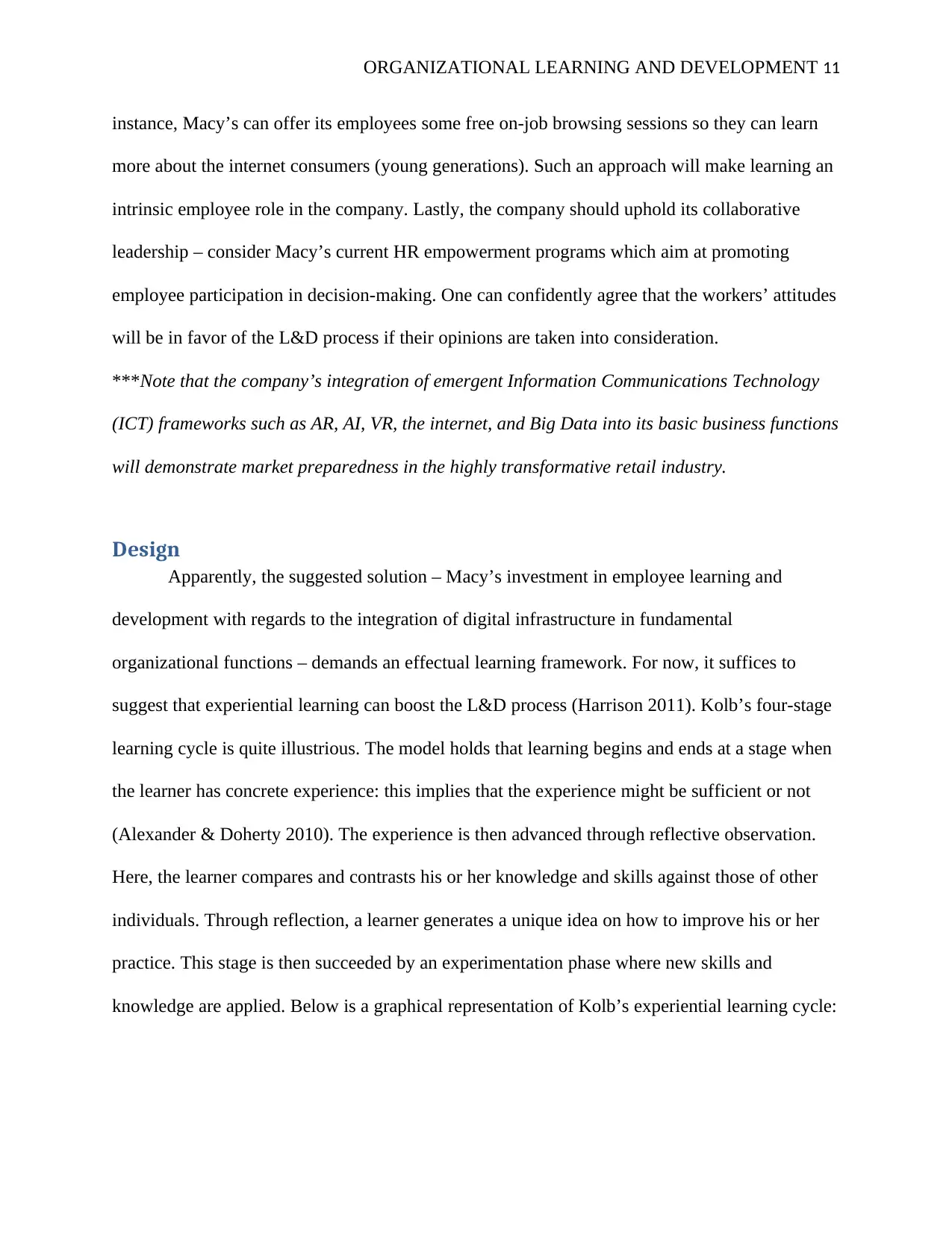
ORGANIZATIONAL LEARNING AND DEVELOPMENT 11
instance, Macy’s can offer its employees some free on-job browsing sessions so they can learn
more about the internet consumers (young generations). Such an approach will make learning an
intrinsic employee role in the company. Lastly, the company should uphold its collaborative
leadership – consider Macy’s current HR empowerment programs which aim at promoting
employee participation in decision-making. One can confidently agree that the workers’ attitudes
will be in favor of the L&D process if their opinions are taken into consideration.
***Note that the company’s integration of emergent Information Communications Technology
(ICT) frameworks such as AR, AI, VR, the internet, and Big Data into its basic business functions
will demonstrate market preparedness in the highly transformative retail industry.
Design
Apparently, the suggested solution – Macy’s investment in employee learning and
development with regards to the integration of digital infrastructure in fundamental
organizational functions – demands an effectual learning framework. For now, it suffices to
suggest that experiential learning can boost the L&D process (Harrison 2011). Kolb’s four-stage
learning cycle is quite illustrious. The model holds that learning begins and ends at a stage when
the learner has concrete experience: this implies that the experience might be sufficient or not
(Alexander & Doherty 2010). The experience is then advanced through reflective observation.
Here, the learner compares and contrasts his or her knowledge and skills against those of other
individuals. Through reflection, a learner generates a unique idea on how to improve his or her
practice. This stage is then succeeded by an experimentation phase where new skills and
knowledge are applied. Below is a graphical representation of Kolb’s experiential learning cycle:
instance, Macy’s can offer its employees some free on-job browsing sessions so they can learn
more about the internet consumers (young generations). Such an approach will make learning an
intrinsic employee role in the company. Lastly, the company should uphold its collaborative
leadership – consider Macy’s current HR empowerment programs which aim at promoting
employee participation in decision-making. One can confidently agree that the workers’ attitudes
will be in favor of the L&D process if their opinions are taken into consideration.
***Note that the company’s integration of emergent Information Communications Technology
(ICT) frameworks such as AR, AI, VR, the internet, and Big Data into its basic business functions
will demonstrate market preparedness in the highly transformative retail industry.
Design
Apparently, the suggested solution – Macy’s investment in employee learning and
development with regards to the integration of digital infrastructure in fundamental
organizational functions – demands an effectual learning framework. For now, it suffices to
suggest that experiential learning can boost the L&D process (Harrison 2011). Kolb’s four-stage
learning cycle is quite illustrious. The model holds that learning begins and ends at a stage when
the learner has concrete experience: this implies that the experience might be sufficient or not
(Alexander & Doherty 2010). The experience is then advanced through reflective observation.
Here, the learner compares and contrasts his or her knowledge and skills against those of other
individuals. Through reflection, a learner generates a unique idea on how to improve his or her
practice. This stage is then succeeded by an experimentation phase where new skills and
knowledge are applied. Below is a graphical representation of Kolb’s experiential learning cycle:
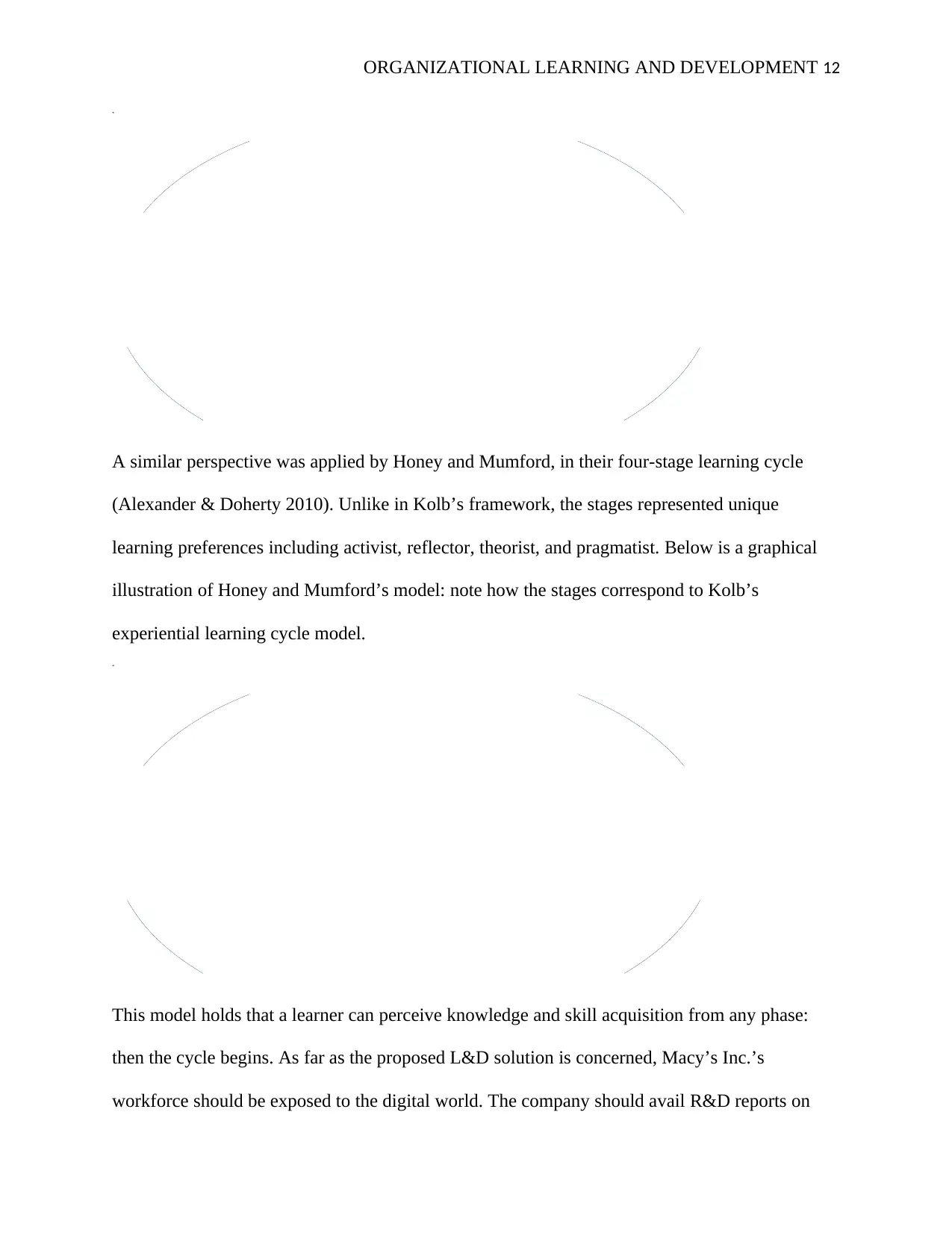
ORGANIZATIONAL LEARNING AND DEVELOPMENT 12
A similar perspective was applied by Honey and Mumford, in their four-stage learning cycle
(Alexander & Doherty 2010). Unlike in Kolb’s framework, the stages represented unique
learning preferences including activist, reflector, theorist, and pragmatist. Below is a graphical
illustration of Honey and Mumford’s model: note how the stages correspond to Kolb’s
experiential learning cycle model.
This model holds that a learner can perceive knowledge and skill acquisition from any phase:
then the cycle begins. As far as the proposed L&D solution is concerned, Macy’s Inc.’s
workforce should be exposed to the digital world. The company should avail R&D reports on
Concr eteExper ien ce
Refle ctiv eObse rvati on
Abstr act
Conce ptu alizati on
ActiveExper ime ntatio n
Activi st
Refle ctor
Theor ist
Pragm ati st
A similar perspective was applied by Honey and Mumford, in their four-stage learning cycle
(Alexander & Doherty 2010). Unlike in Kolb’s framework, the stages represented unique
learning preferences including activist, reflector, theorist, and pragmatist. Below is a graphical
illustration of Honey and Mumford’s model: note how the stages correspond to Kolb’s
experiential learning cycle model.
This model holds that a learner can perceive knowledge and skill acquisition from any phase:
then the cycle begins. As far as the proposed L&D solution is concerned, Macy’s Inc.’s
workforce should be exposed to the digital world. The company should avail R&D reports on
Concr eteExper ien ce
Refle ctiv eObse rvati on
Abstr act
Conce ptu alizati on
ActiveExper ime ntatio n
Activi st
Refle ctor
Theor ist
Pragm ati st
⊘ This is a preview!⊘
Do you want full access?
Subscribe today to unlock all pages.

Trusted by 1+ million students worldwide
1 out of 21
Related Documents
Your All-in-One AI-Powered Toolkit for Academic Success.
+13062052269
info@desklib.com
Available 24*7 on WhatsApp / Email
![[object Object]](/_next/static/media/star-bottom.7253800d.svg)
Unlock your academic potential
Copyright © 2020–2025 A2Z Services. All Rights Reserved. Developed and managed by ZUCOL.




